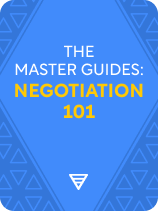

This article is an excerpt from the Shortform book guide to "The Master Guides: Negotiation" by Shortform. Shortform has the world's best summaries and analyses of books you should be reading.
Like this article? Sign up for a free trial here.
What’s the Ackerman Model for negotiating? Why is the Ackerman Model a good alternative to traditional negotiating?
Created by ex-CIA operative Mike Ackerman, this model is based on the offer-counteroffer system. It uses a tapering system that brings the ultimate number (whether it’s the price you’ll be paying or the price you’ll be receiving) closer to your preference.
Below, we’ll explore some of the key steps in the Ackerman Model.
1) Choose a Target Price
This first step of the Ackerman Model should be ambitious, but reasonable. You don’t want to negotiate with yourself and set your target price too high (if you’re the buyer), but you also don’t want to set it so low that your counterpart would never agree to it. Doing some research beforehand will help you set your goal. William Ury and Roger Fisher (Getting to Yes) similarly caution against starting with an unreasonable position, as it can set off a struggle of wills with each side trying to force its position on the other. This leads to mounting anger and resentment—and if the bad feelings linger, it can become hard to reach a deal.
2) Offer 65% of Your Target Price
Thus, if you’re aiming to pay $100,000, your opening bid should be $65,000. This is a starting bid designed to catch your counterpart off guard. Voss writes that an extreme starting bid like this can also trigger your own sense of loss aversion in a constructive way. By starting with a low offer, you’ll start thinking of anything higher than that as a “loss,” which you’ll work hard to avoid. In reality of course, you’re still well below your target price at this point, so even if you move off your opening bid it’s still a “win” for you.
However, Ury and Fisher (Getting to Yes) warn that this sort of “positional bargaining” can compel negotiators to become rigid in their positions to the point where they can’t accept any offer if it doesn’t meet their original position—even if that offer is better than no deal at all. The harder you try to convince the other side of the rightness of your position, and the more you defend it against attack, the more strongly committed to it you become. You feel compelled to maintain consistency with your past positions and to save face by not giving in.
3) Plan Your Counteroffers
When planning your counteroffers, use three increases—but each time, reduce the size of the increase. For example, Chris Voss recommends countering at first with a number that’s 85% of your target price (a 20 percentage-point jump). Then, you increase it to 95% of your target price (only a 10 percentage-point jump this time). If they’re still not accepting this, then finally you meet them at your full target price (which by this point is a modest 5 percentage-point jump).
All of this activates your counterpart’s emotional instinct to be fair, reasonable, and reciprocal. Most people, writes Voss, are naturally inclined to match what they see as generosity toward themselves with generosity of their own toward others—indeed, most people don’t want to feel like they’re freeloaders. So when they see you making what appear to be concessions (even though you’re only really going up to your actual target price), they’ll be more likely to want to match that “generosity” with generosity of their own.
Deepak Malhotra and Max Bazerman (Negotiation Genius) write that you can also respond by making an aggressive counteroffer and then suggesting both sides moderate their offers. You can then take control of the conversation by explaining why you made your counteroffer.
An example of this tactic might look something like this: You’re negotiating a salary for a new job. The initial offer is $100,000 per year, but you believe this to be below-market. You might make an aggressive counteroffer by asking for $130,000, arguing that the market rate for the position and your unique skills, experience, and proven track record merit this. But you then concede that this number is much higher than their initial offer and may be beyond what their budget can support.
Having acknowledged this, you then signal a willingness to find a middle ground, telling the employer that you really want the job and are committed to reaching a number that you’re both happy with. You suggest that you both abandon your “extreme” positions and reach a number that makes sense for both parties. You ask for $110,000 and gauge how they react to your concession. Thus, you begin with an aggressive counteroffer to assert your value, but you also recognize the need for flexibility and demonstrate understanding and empathy for the employer’s perspective.
4) Signal When You’ve Reached Your Limit
Voss recommends including a non-monetary item along with your final offer to signal that you’re truly at your limit. For example, after you’ve made your final offer in a salary negotiation, you might signal that this is your final offer by shifting the discussion to other elements of the job, like your title, flexible work schedule, and office location. By pivoting to something other than money, you’re sending a message to your counterpart that the monetary portion of the negotiation is over, and you’re ready to move on to other items.
In Negotiation Genius, Malhotra and Bazerman write that it’s important to keep an eye out for the concessions your counterpart is making during the negotiation. When her concessions progressively get smaller, it may mean that you’re approaching her RV—her worst possible deal, the minimum she’d be willing to accept. At this point, she’s probably less flexible about how much she can concede. However, Malhotra and Bazerman warn that your counterpart may also use this as a tactic to confuse you about her real limits—deceiving you into thinking she can’t make any more concessions, when in fact she can.

———End of Preview———
Like what you just read? Read the rest of the world's best book summary and analysis of Shortform's "The Master Guides: Negotiation" at Shortform.
Here's what you'll find in our full The Master Guides: Negotiation summary:
- How we're always negotiating, even if we don't realize it
- A synthesis of ideas and recommendations from leading negotiation experts
- A look into two different approaches to negotiation: emotional and rational






